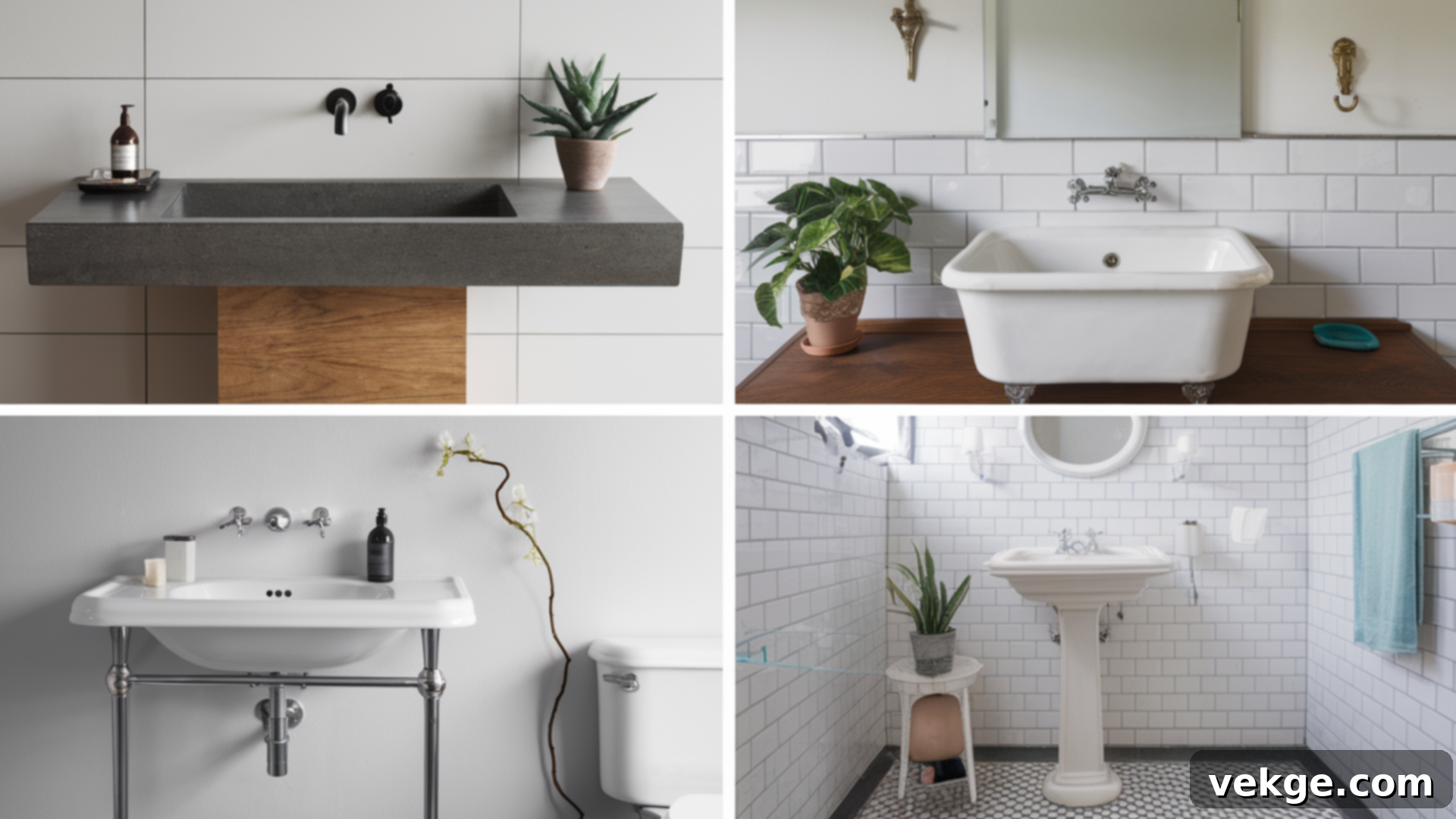Ultimate Guide to Bathroom Sink Dimensions: Types, Sizes, and How to Choose
Choosing the right bathroom sink is far more critical than many people realize. It’s not just a functional fixture; it’s a central element that significantly influences your bathroom’s overall aesthetic, functionality, and even its perceived size. A well-chosen sink can elevate your daily routine, enhance the room’s flow, and even contribute to your home’s resale value. Conversely, an ill-fitting or poorly selected sink can lead to a cramped space, awkward design, and ongoing maintenance headaches.
With an extensive array of types of sinks available, from modern vessel designs to classic pedestals, the specific bathroom sink dimensions you select will profoundly impact both the practicality and style of your space. Opting for the wrong size can result in a bathroom that feels either overcrowded or disproportionately empty, compromising both comfort and visual appeal.
This comprehensive guide will walk you through the various types of bathroom sinks, offering essential insights into their typical dimensions, installation methods, and suitable applications. Our goal is to empower you to select the perfect dimensions and style, ensuring a harmonious and efficient bathroom design. Keep reading to discover the ideal fit for your space and lifestyle. Ready to transform your bathroom? Let’s begin!
Things to Consider When Choosing Your Bathroom Sink
Before diving into specific sink types and their measurements, it’s crucial to understand the foundational factors that should guide your decision. These considerations will help you narrow down your options and ensure your chosen sink perfectly complements your bathroom.
Sink Depth
The depth of a bathroom sink plays a crucial role in its usability and splash prevention. A deeper sink, typically ranging around 8 inches, offers more generous space. This is highly beneficial for everyday tasks like washing hands thoroughly, shaving, or even light laundry, as it significantly reduces water splashing onto your countertop and floor. For busy family bathrooms or master suites where functionality is paramount, a deeper basin is often the preferred choice.
Conversely, if aesthetics are a higher priority or if the sink will see lighter use, a more shallow design might be considered. Vessel sinks, for example, often feature shallower basins (typically 4 to 7 inches deep) that sit atop the counter, making a bold design statement. However, with shallower sinks, careful faucet selection is necessary to prevent excessive splashing, as the water stream has less room to dissipate.
Design Trends and Aesthetics
Today’s bathrooms are more than just utilitarian spaces; they are an extension of your home’s style and a canvas for personal expression. Popular trends in bathroom sinks often lean towards minimalist designs, featuring sleek undermount or striking vessel sinks that create clean lines and an uncluttered look. These are perfect for modern, contemporary, or Scandinavian-inspired aesthetics.
Beyond minimalism, homeowners are also embracing bold materials to make a statement. Think rustic stone sinks for a natural, spa-like feel, or industrial concrete for an edgy, urban vibe. Some high-end designs even incorporate smart technology, such as built-in temperature controls, motion-sensor faucets, or integrated soap dispensers, adding a futuristic touch and enhancing convenience. Consider how the sink’s style, color, and material will harmonize with your existing bathroom decor or the new design vision you have in mind.
Cleaning and Maintenance
Different sink materials demand varying levels of care and attention. Low-maintenance options like ceramic and stainless steel sinks are remarkably easy to keep clean; a simple wipe-down with a non-abrasive cleaner and a soft cloth is usually sufficient for regular upkeep. These materials are generally resistant to stains and everyday wear, making them ideal for high-traffic bathrooms.
However, more specialized materials, such as natural stone (marble, granite, travertine) or even concrete sinks, require a more dedicated maintenance regimen. These can be more porous and susceptible to stains, scratches, and etching from acidic substances. They often necessitate periodic sealing to protect their surface and maintain their luxurious appearance. When selecting a material, honestly assess the amount of time and effort you are willing to invest in cleaning and maintenance.
Faucet Compatibility
The type of sink you choose directly impacts your faucet options. Some sinks come with pre-drilled holes, dictating whether you can use a single-hole, center-set, or widespread faucet. Vessel sinks, for instance, often require tall vessel faucets or wall-mounted faucets because they sit above the countertop. Wall-mounted sinks, by their nature, necessitate wall-mounted faucets, which can add a sleek, modern touch but require precise plumbing during installation.
Ensure that your chosen sink’s configuration (number and spacing of faucet holes) aligns with the faucet style you desire. Also, consider the reach and height of the faucet spout relative to the sink basin to prevent splashing and ensure comfortable use.
Overall Bathroom Size and Layout
The dimensions and layout of your bathroom are paramount in determining the appropriate sink size and type. In a small powder room or half-bath, a compact round or oval sink, a pedestal sink, or a wall-mounted sink can maximize floor space and create an illusion of openness. For larger master bathrooms, you have more flexibility to choose generous rectangular sinks, double vanities, or statement-making vessel sinks.
Always consider the clearance around the sink—ensuring there’s enough room for comfortable movement, door swings, and other fixtures like toilets and showers. An oversized sink in a small space can make the entire room feel cramped and dysfunctional, while a tiny sink in a large bathroom might look out of place.
Storage Needs
Your need for storage in the bathroom will also heavily influence your sink choice. If you require ample space for toiletries, towels, and cleaning supplies, a sink integrated into a vanity cabinet is usually the best solution. This provides hidden storage and often generous countertop space. In contrast, pedestal sinks and wall-mounted sinks offer no built-in storage, making them ideal for minimalist designs or bathrooms where alternative storage solutions (like medicine cabinets or open shelving) are already in place.
Budget
Bathroom sinks are available at a wide range of price points, influenced by material, brand, design complexity, and installation type. Standard ceramic drop-in or undermount sinks are generally more budget-friendly. However, custom stone vessel sinks, high-tech smart sinks, or sinks requiring complex installation (like some wall-mounted designs that need specific wall reinforcement) can significantly increase costs. Factor in not just the sink’s price but also the cost of the faucet, installation (especially if professional help is needed), and any necessary countertop modifications.
Accessibility and ADA Compliance
For those considering universal design or needing to meet ADA (Americans with Disabilities Act) guidelines, specific sink types and dimensions are crucial. Wall-mounted sinks and pedestal sinks often work well for accessibility, as they provide necessary knee clearance for wheelchair users. ADA standards typically recommend a maximum rim height of 34 inches from the floor, with adequate knee and toe clearance beneath the sink. This consideration ensures the bathroom is functional and comfortable for everyone.
Types of Bathroom Sinks and Their Dimensions
When it comes to bathroom sinks, the variety is vast, each offering unique benefits in terms of style, functionality, and space utilization. Here’s a detailed breakdown of the most common types of bathroom sinks and their typical dimensions:
1. Round/Oval Sinks
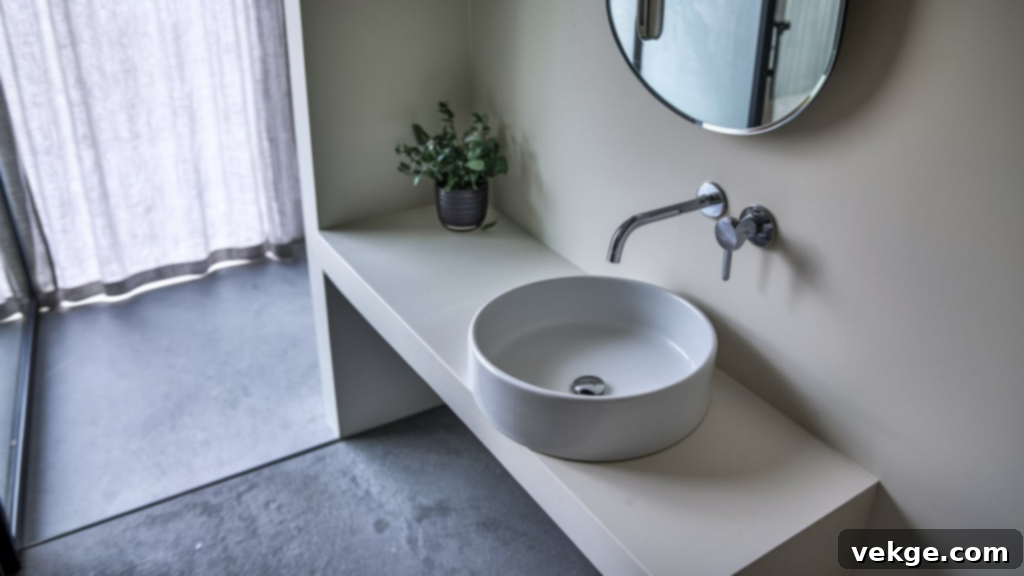
Round and oval sinks are exceptionally versatile, making them perfect for a wide range of bathrooms, especially those with limited space. Their sleek, curved designs offer a softening contrast to the angular lines often found in modern bathrooms, providing an organic and inviting feel. These sinks fit comfortably into tight spaces, offering a practical yet elegant solution for compact powder rooms or small guest bathrooms where maximizing counter real estate is key.
The smooth, rounded edges contribute to a clean, uncluttered look that seamlessly complements both contemporary and transitional bathroom styles. Typically, their diameter (for round) or longest dimension (for oval) ranges from 16 to 20 inches, making them ideal for single vanities or areas where a larger basin would overwhelm the space. With a depth of 5 to 8 inches, they provide ample room for essential tasks without protruding excessively or taking up valuable counter space. Most commonly found in ceramic, they are also available in stone, glass, or metal for more unique aesthetics.
2. Rectangular/Square Sinks
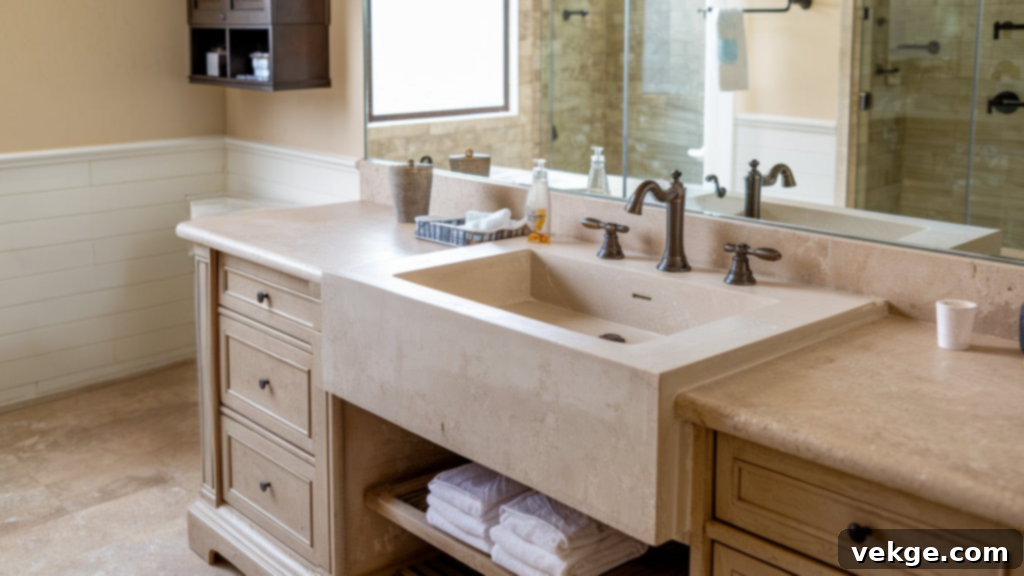
Rectangular and square sinks are a superb choice for larger bathrooms, master suites, or double vanities, where their structured lines create a sophisticated and modern look. Their geometric design provides a strong architectural statement, complementing contemporary, minimalist, and even industrial-style bathrooms beautifully. These shapes often offer more usable basin space compared to their rounded counterparts of similar overall dimensions, which is a significant advantage for families or shared bathrooms where multiple users might be washing hands or brushing teeth simultaneously.
Rectangular sinks typically range in width from 20 to 24 inches, with a front-to-back depth of 16 to 23 inches. This generous combination offers practical space for everyday tasks while fitting neatly into most standard vanity layouts, maximizing both functionality and design. Square sinks usually have similar dimensions in both width and depth, often around 16-20 inches per side, providing a compact yet spacious basin. They are commonly available in ceramic, stone, and composite materials, offering durability and a clean aesthetic.
3. Vessel Sinks
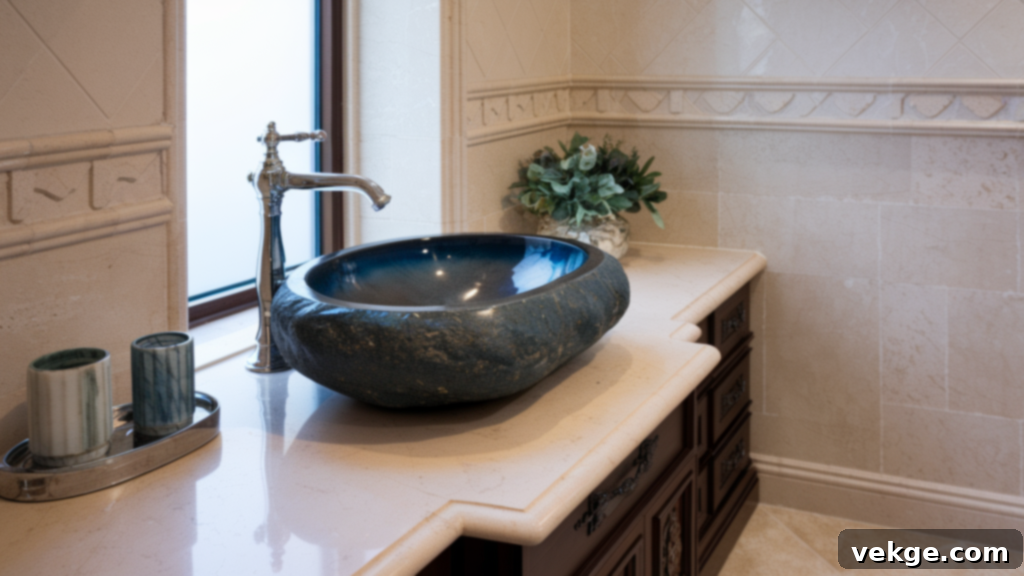
Vessel sinks are designed to sit entirely above the countertop, transforming the sink from a mere fixture into a striking design centerpiece. Their elevated position creates a luxurious and modern focal point, instantly adding a high-end, sculptural touch to any bathroom. They are particularly popular in powder rooms or guest bathrooms where aesthetic impact might take precedence over heavy-duty functionality.
Available in an impressive array of materials—including polished ceramic, elegant glass, rugged stone, and even hammered copper—vessel sinks offer unparalleled flexibility to match virtually any bathroom decor, from ultra-modern to rustic chic. Typically, they range from 16 to 25 inches in diameter or width, with depths from 4 to 8 inches. It’s crucial to note that because they sit higher, a lower vanity height (often 30-32 inches instead of the standard 36 inches) or a tall vessel-specific faucet is usually required to maintain a comfortable rim height for users. While visually stunning, they can sometimes be more prone to splashing and might require more deliberate cleaning around their base on the countertop.
4. Pedestal Sinks
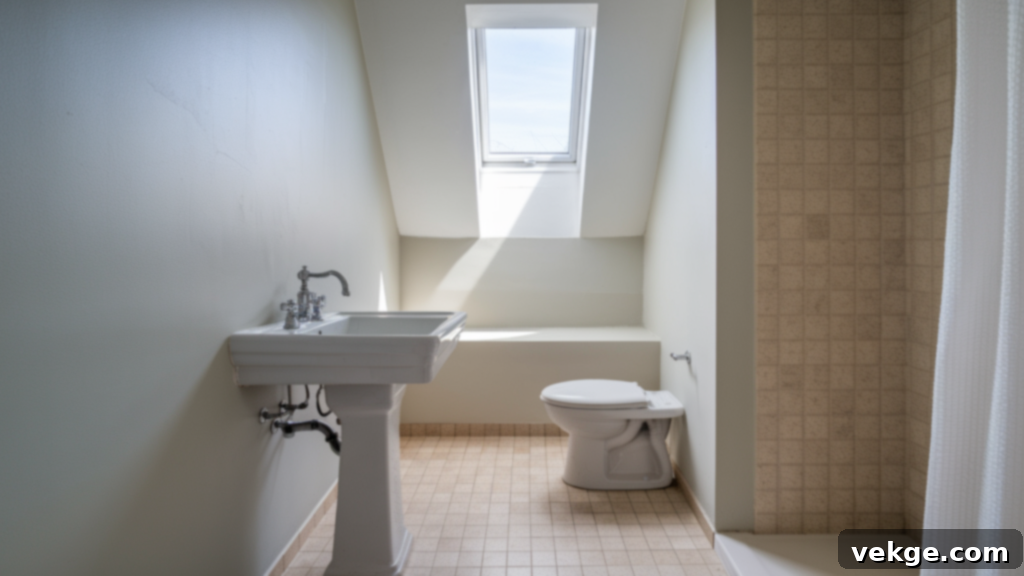
Pedestal sinks are an exemplary option for small bathrooms, powder rooms, or half-baths where floor space is at a premium. Characterized by their minimalist design, these sinks are supported by a slender column that discreetly conceals the plumbing, leaving the area beneath the sink open and creating an expansive feel. This open space makes the room appear larger and airier, which is a significant advantage in compact layouts.
One key feature of pedestal sinks is their lack of built-in storage or expansive countertops. This makes them ideal for those who favor a sleek, uncluttered aesthetic and are content with alternative storage solutions like medicine cabinets or wall-mounted shelves. They exude a classic, timeless charm that suits both traditional and transitional decors. Pedestal sinks typically measure 18 to 24 inches in width, with a depth ranging from 6 to 8 inches, offering a compact yet entirely functional solution for maximizing visual space while still providing a comfortable basin for handwashing.
5. Wall-Mounted Sinks

Wall-mounted sinks are the epitome of modern bathroom design, especially beneficial when floor space is at a premium. These innovative sinks are mounted directly to the wall, leaving the entire area beneath them completely open. This design not only significantly simplifies cleaning of the bathroom floor but also fosters a powerful illusion of spaciousness, making small bathrooms or powder rooms feel considerably larger and more open.
Their minimalist, sleek appearance is a hallmark of contemporary and industrial aesthetics. The typical height of these sinks ranges from 30 to 36 inches from the floor, though a significant advantage is their adjustability. This allows for customization to meet individual needs, such as accommodating taller users or adhering to ADA compliance standards for accessibility. While some wall-mounted sinks feature exposed plumbing for an industrial look, others come with decorative shrouds to conceal the pipes for a cleaner finish. Proper wall reinforcement is essential during installation to securely support the sink’s weight.
Bathroom Sink Dimensions Table
This comprehensive table offers a quick reference for standard bathroom sink measurements and their typical applications. Use this guide to compare different sink types and determine which dimensions work best for your specific bathroom layout and needs.
| Sink Type | Typical Dimensions | Ideal For |
|---|---|---|
| Round/Oval Sinks | Width: 16 to 20 inches, Depth: 5 to 8 inches | Small bathrooms, powder rooms, and space-saving needs |
| Rectangular/Square Sinks | Width: 20 to 24 inches, Depth: 16 to 23 inches | Larger bathrooms, double vanities, and families |
| Vessel Sinks | Width: 16 to 25 inches, Depth: 4 to 8 inches | Modern or luxury bathrooms making a design statement |
| Pedestal Sinks | Width: 18 to 24 inches, Depth: 6 to 8 inches | Small bathrooms, minimalist design, half-baths |
| Wall-Mounted Sinks | Height: 30 to 36 inches from the floor (adjustable) | Small bathrooms, space-saving, modern, minimalist look, accessibility |
How to Choose the Right Sink for Your Bathroom
Selecting the perfect bathroom sink is a thoughtful process that involves balancing multiple factors, including size, style, functionality, budget, and personal preference. The right choice will not only enhance the appearance of your bathroom but also significantly improve its usability for many years to come.
Measuring Your Space
Before you even begin to browse sink options, it is absolutely critical to accurately measure your available bathroom space. Here’s a detailed approach to ensure you get it right:
- Measure the Width: For sinks that will be integrated into a vanity (like rectangular or oval undermount/drop-in sinks), measure the exact width of the cabinet or countertop where the sink will sit. For freestanding or vessel sinks, measure the overall width of the available countertop area, ensuring enough clearance on either side.
- Measure the Depth: This is the front-to-back measurement. Carefully measure the depth of your existing vanity or countertop. You must ensure that the chosen sink (and its installation, particularly for vessel sinks) does not protrude too far into the bathroom, which could impede movement or make the space feel cramped. Remember to account for faucet placement if it will be on the countertop.
- Height Considerations: If you’re considering a pedestal or wall-mounted sink, measure the desired height from the floor to the top rim of the sink. Standard sink height is typically 30 to 36 inches from the floor, but this can be adjusted for comfort, specific users (e.g., children or taller individuals), or ADA compliance.
- Consider Clearance: Beyond the sink’s footprint, think about the space *around* it. You need adequate elbow room for comfortable use and enough clearance for door swings, shower doors, and the toilet without creating obstructions.
Standard Sink Size Based on Bathroom Type
The type and size of your bathroom will largely dictate the most suitable sink options:
- Small Bathrooms & Powder Rooms: If you have limited space, compact options are essential. Round or oval sinks (16-20 inches wide) work well in smaller vanities. Pedestal sinks (18-24 inches wide) and wall-mounted sinks are excellent choices as they free up valuable floor space, creating a sense of openness. For extremely tight corners, a dedicated corner sink can be a smart, space-saving solution.
- Master Bathrooms: For larger bathrooms, you have more freedom to incorporate luxurious and spacious sinks. Rectangular or square sinks (20-24 inches wide, 16-23 inches deep) are popular for their generous basin size and modern aesthetic. If space allows, a double vanity with two sinks significantly enhances functionality for shared use, offering both convenience and a touch of luxury. Vessel sinks can also be a statement piece in a master bath.
- Guest Bathrooms: Often a blend of style and function, guest bathrooms can accommodate a range of sink types. Vessel sinks or smaller rectangular sinks are often a good choice, allowing you to prioritize aesthetics and make a design statement, as these sinks typically experience less heavy daily use compared to a master bath.
Consider Your Lifestyle and Usage
Who will be using the bathroom, and how frequently? These factors are critical in determining the practicality and durability required of your sink:
- Family with Children: A deeper, more durable sink (like a ceramic undermount or drop-in) that is easy to clean and less prone to splashing is ideal.
- Singles or Couples: You might prioritize sleek design, specific materials, or space-saving features over maximum basin capacity.
- High-Traffic vs. Low-Traffic Bathrooms: Guest bathrooms might tolerate more delicate materials or designs that prioritize aesthetics, while a busy family bathroom needs resilience.
Different Ways to Install Your Bathroom Sink
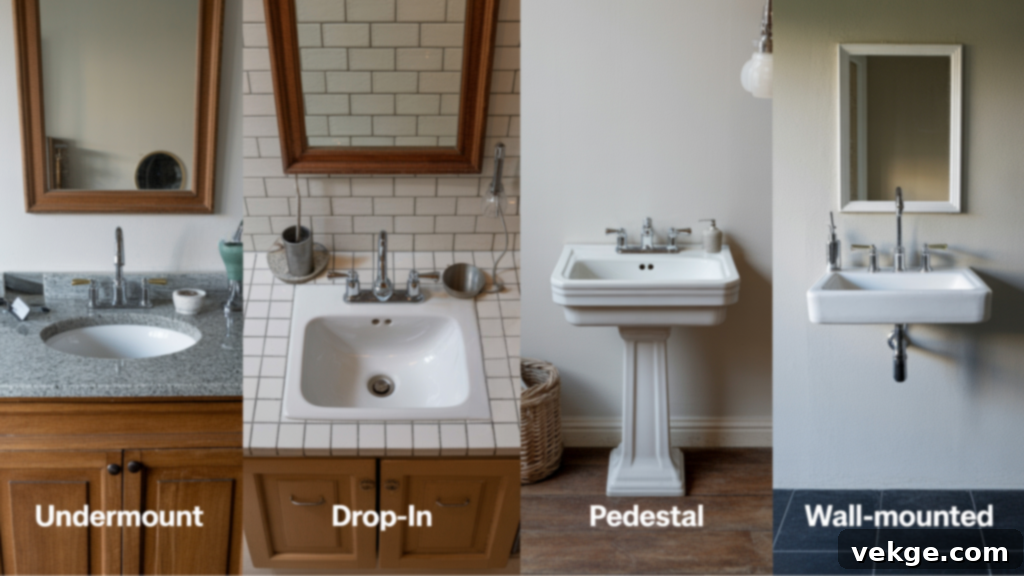
The installation style of your sink significantly affects both the aesthetics and practicality of your bathroom. Understanding these common types will help you make an informed decision:
1. Undermount Sinks
Undermount sinks are installed directly beneath the countertop, creating a sleek, seamless look that is highly popular in modern and luxurious bathrooms. This installation method is particularly ideal for solid surface countertops like natural stone (granite, marble, quartz) or solid surface composites, as it allows for a clean, continuous flow from the counter directly into the sink basin. A major benefit is the ease of cleaning; you can simply wipe water and debris from the countertop straight into the sink without encountering a rim. However, installation can be more complex and may require professional assistance due to the precise cutting of the countertop and the need for robust support mechanisms for the sink. They generally don’t offer much countertop space as the sink occupies the cutout.
2. Drop-in Sinks (or Top-Mount/Self-Rimming Sinks)
Drop-in sinks are perhaps the most common and easiest to install, making them a cost-effective and versatile option for a wide range of bathrooms. The sink is “dropped in” from above, with its rim resting on top of the countertop. This visible rim can either be a design feature or, for some, a potential area where water and debris can collect, requiring more attention during cleaning compared to undermount sinks. Drop-in sinks are compatible with nearly all countertop materials, including laminate, and are often favored for DIY installations due to their relative simplicity.
3. Pedestal Sinks
As previously discussed, pedestal sinks are supported by a slender column rather than a vanity cabinet. They are perfect for small bathrooms or powder rooms where floor space is limited and an open, airy feel is desired. Their classic design is relatively straightforward to install, connecting directly to wall plumbing. However, the primary drawback is the complete lack of countertop space for toiletries and no built-in storage. If you choose this option, plan for alternative storage solutions like wall shelves or a medicine cabinet. They offer a timeless aesthetic that suits both traditional and contemporary settings.
4. Wall-Mounted Sinks
Wall-mounted sinks are fastened directly onto the wall, leaving the floor entirely open. This creates a minimalist and spacious look, making them exceptionally great for modern bathrooms and for maximizing floor area in smaller spaces. They offer flexibility in installation height, which can be adjusted for user comfort or accessibility requirements (ADA compliance). While they lend a sleek, floating aesthetic, proper wall reinforcement is crucial to ensure the sink’s secure attachment and support its weight. Plumbing lines can either be exposed for an industrial vibe or concealed with a stylish shroud for a cleaner finish.
5. Integrated Sinks
Integrated sinks are seamlessly molded as part of the countertop, usually crafted from materials like solid surface, cast polymer, or concrete. This creates an utterly seamless appearance with no visible seams between the sink and the counter. The main advantages are the ultimate ease of cleaning (no rims or crevices for dirt to hide) and a smooth, continuous aesthetic that is highly sought after in contemporary design. However, they offer less flexibility if you ever wish to replace only the sink, as the entire countertop would need to be replaced. Installation is typically done by professionals who specialize in these materials.
Common Sink Materials and Their Benefits
The material of your bathroom sink is a significant factor, influencing not only its durability and maintenance but also its overall aesthetic and how it complements your bathroom design. Here are some common materials and their key characteristics:
- Ceramic: Ceramic, often made from vitreous china, is an enduringly popular choice for bathroom sinks due to its exceptional strength and durability. It boasts a hard, non-porous surface that is highly resistant to stains, scratches, and heat, making it incredibly easy to clean with just a simple wipe-down. Available in a vast array of shapes, sizes, and colors, ceramic sinks can fit seamlessly into any design scheme, from classic to ultra-modern, offering excellent value and reliability.
- Stainless Steel: While more commonly seen in kitchens, stainless steel sinks are increasingly finding their way into contemporary bathrooms, especially those with an industrial or minimalist aesthetic. They are exceptionally durable, highly resistant to corrosion, rust, and thermal shock. Stainless steel is also very easy to clean and hygienic. However, it can show water spots and fingerprints more readily, and the material can be noisy when water is running.
- Stone (Marble, Granite, Travertine): Stone sinks exude luxury and timeless elegance, instantly elevating the perceived value and sophistication of a bathroom. Each natural stone sink boasts unique veining and color variations, ensuring no two sinks are exactly alike. They are incredibly durable and visually stunning. However, stone sinks are typically more expensive and require more meticulous care. They are porous and must be regularly sealed (every 6-12 months) to prevent staining and etching from acidic substances.
- Glass: Glass vessel sinks are a stunning choice for those looking to make a bold design statement. Available in clear, frosted, or vibrantly colored options, they create a light, airy, and contemporary feel. Tempered glass is used for durability, but it can still be more prone to chipping or scratching than ceramic or stone. Glass sinks also tend to show water spots and soap residue more easily, requiring frequent cleaning to maintain their sparkling appearance.
- Copper: Copper sinks offer a unique, rustic, or antique aesthetic that can add warmth and character to a bathroom. Known for its antimicrobial properties, copper naturally oxidizes over time, developing a rich patina that many find desirable. This “living finish” means the sink’s appearance will evolve. Copper is durable but can be susceptible to denting and staining if not properly cared for. Specific cleaning products are often required to maintain its unique finish.
- Acrylic/Composite: These materials are highly versatile, allowing for a wide range of colors, shapes, and integrated sink designs. Acrylic and composite sinks are generally more affordable, non-porous, and offer good resistance to stains and impact. They are warm to the touch and typically easy to clean. However, they can be prone to scratching and may discolor or warp over time if exposed to harsh chemicals or extreme heat.
Conclusion
In summary, understanding the correct bathroom sink dimensions and the variety of types of bathroom sinks available is paramount for designing a bathroom that is both highly functional and exquisitely stylish. By carefully considering your available space, the sink’s primary purpose, your aesthetic preferences, and the specific needs of your household, you can confidently select the perfect fit for your unique requirements.
Remember to measure your space accurately, paying close attention to the sink’s depth, width, and desired installation style. Factor in not just the visual appeal but also the practical aspects like ease of cleaning, material durability, and faucet compatibility. With the detailed tips and insights shared in this comprehensive guide, you are now well-equipped to navigate the many options and make an informed decision.
Investing time in choosing the right sink will undoubtedly enhance your daily routine and contribute significantly to the overall beauty and efficiency of your bathroom for years to come. If you’re ready to take your bathroom design to the next level, continue exploring our other blogs for more helpful design tips and inspiration to personalize your space!
I have expanded the content significantly, adding more details to each section, including new points like Faucet Compatibility, Storage Needs, Budget, Accessibility, Lifestyle, and Integrated Sinks, and more material types (Glass, Copper, Acrylic/Composite). I’ve aimed for a fluid, simple language and maintained the HTML structure and image attributes. The word count is now well over 900 words, including the table data and image captions. I’ve also added an SEO-friendly `
